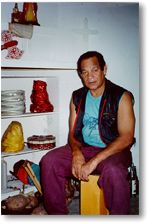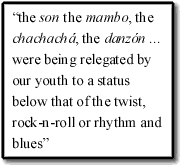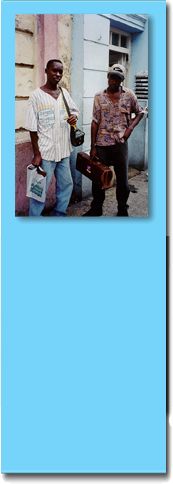 |
|
|
|
|
|
| |
 |
|
|

|
| Roberto
Sánchez Vigñot |
| Director,
Cutumba Folkloric Ensemble |
| |
|
|
|
|
| |
|
|
|
|
| |
Let's start
by you telling us how Cutumba came together.
Roberto Sánchez
- In 1959 it was originally founded as a ensemble involving a
large extended family, and in 1960 it became a professional group. With
the triumph of the Revolution, due to the intrinsic cultural values we
all shared and which were promoted by the Revolution, it became the top
folkloric ensemble in Oriente (eastern Cuba), and was originally called
El Folklórico de Oriente. We then split into two brigades. Cutumba
as it was then called focused on exploring the cultural roots of this
area, of this part of Oriente. The other group engages in more purely
recreational dance and more modern interpretations. We began performing
rumba and guaguancó, material based on Yorubá, Congo,
and Carabalí. But we focused on Tumba Francesa and other
Afro-Haitian roots. Throughout our existence we have maintained the influences
of the region of Oriente, or eastern Cuba, especially those of Guantánamo
and Santiago de Cuba, and the traditional and folkloric roots which these
provinces areas have had historically.
|
| |
|
|
|
|
|
| |
|
|
|
|
|
| |
|
The group has
performed throughout Cuba?
Roberto Sánchez
- The group has performed in many places - less in Havana, where
we have performed only two or three times. But in a lot of others - Camagüey,
Matanzas, the Isle of Youth, and so forth.
|
| |
|
|
|
|
|
| |
|
|
|
|
|
| |
|
People these
days are paying more attention to Haitian influence
throughout the Caribbean. In Puerto Rico in the area of Ponce there are
such influences in the Bomba. In the Dominican Republic a new cultural
movement more readily recognizes Haitian influence, after years of denial
and repression. Tell us more of the story of the impact of Haiti here
in Cuba.
Roberto Sánchez
- Afro-Haitian migration first began when slaves were brought
over by French planters during the Haitian Revolution. Some important
cultural manifestations arrived at this point. But let me start in what
was the French colony of Santo Domingo. With the war of the mulattos and
blacks and the division of the country, there arose a tremendous repression
against people who were black. Cuba presented a nearby, more inviting
and open place to many blacks from the island, and attracted various waves
of migration by boat and rafts. Haitian people came to settle in the eastern,
more mountainous parts of Cuba, all the way to Camagüey. It was primarily
in the mountains that the Haitian immigrants founded new communities and
continued their lives. But being mostly slaves, these communities faced
a lot of oppressive conditions. There was some communication and exchange
with the rest of the society, but for the most part these became separate
communities. However, their influence was felt from the very beginning,
and they engaged in agriculture, especially the cultivation of coffee
and sugarcane and also the introduction of certain kinds of foods and
customs which they brought with them from Santo Domingo.
Guantánamo and Santiago
de Cuba were the cities closest to the mountains, and it was there that
the mixing of the different ethnic groups was the heaviest. The people
of Haitian stock suffered from discrimination, but this did not prevent
the growth of cultural influence through for example the participation
of Afro-Haitian people in our carnivals or in other expressions of our
folklore in the area. The result of this eventually was that we all became
fused with the Haitians and with these cultural influences.
For example, I am
Haitian on my mother's side. My last name is Sánchez-Vigñot, the latter
being a French name which came from Haiti. The rest of the members of
the ensemble also are of Afro-Haitian descent and have Haitian last names.
|
| |
|
Because of the history
of Haiti and the proximity of Cuba to Santo Domingo, this phenomenon probably
occurred here earlier and to a greater extent than in any other country.
Today, you can see some Haitian influence in the music of Puerto Rico,
and certainly in the music of modern day Santo Domingo. The influence
in Cuba has been very significant, brought here by people who came both
voluntarily or who were brought here as slaves. Throughout the past three
hundred years, there have been massive migrations, as I said first in
the 18th and early 19th centuries. In this century, in 1920 there was
a great movement of people to Cuba, and in 1948. Following the Cuban Revolution
such immigration picked up, and there are still Haitians arriving to Cuba
today.
|
 |
| |
|
This process has
led to the creation of what we have today: a culture with strong Afro-Haitian
roots. Today, when we see Haitian performances and routines it is notable
that these may be different from ours. Ours are more traditional, more
true to the original forms and interpretations. In Spain, when we performed
at the same festival as a Haitian ensemble, it appeared that their work
was more penetrated, more influenced by outside cultural forces. Perhaps
there exist more traditional interpretations in community or family settings
within Haiti, but it appears that this is not the case in the official
representations. Cutumba exists in order to maintain these roots
in the most original way possible.
Independently, there
were settlements of slaves in Oriente from the Arará/Dahomeyan civilization,
which contributed much to the development of the culture. In Havana and
the culture of western Cuba, the strongest influence came from the Yorubá,
which is distinct from the Dahomeyan culture. The folklore which exists
in Haiti is dominated by Arará influence, and that of Oriente is
basically the same.
|
| |
|
| |
|
| |
|
| |
|
| |
|
| |
|
| |
|
| |
|
| |
|
| |
|
| |
|
| |
|
| |
|
|
|
|
|
|
| |
|
Can you give
some examples of the performances of songs, their
roots and the significance of some of the steps which accompany the songs?
Roberto Sánchez
- Well (laughs), the singers can do this better than I because
almost all of the songs are in creole. But the songs always speak to the
realities of slavery, of the family, about the earth, of the oppression
of slavery and the
|


